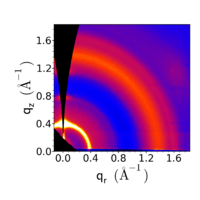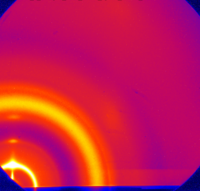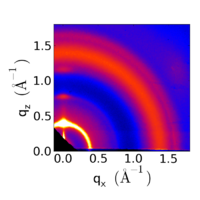Difference between revisions of "GIWAXS"
KevinYager (talk | contribs) |
KevinYager (talk | contribs) |
||
| Line 2: | Line 2: | ||
There is no unambiguous delineation between WAXS and SAXS; generally speaking, WAXS corresponds to angles from approximately 1° to 45°, or ''q''-values from 0.1 Å<sup>−1</sup> to 5 Å<sup>−1</sup> (6 nm to Angstroms). | There is no unambiguous delineation between WAXS and SAXS; generally speaking, WAXS corresponds to angles from approximately 1° to 45°, or ''q''-values from 0.1 Å<sup>−1</sup> to 5 Å<sup>−1</sup> (6 nm to Angstroms). | ||
| + | |||
| + | {| | ||
| + | Example GIWAXS data for a [[P3HT]] thin film. | ||
| + | |- | ||
| + | | [[Image:P3ht calibration01.png|thumb|200px|Raw detector image.]] | ||
| + | | [[Image:P3ht calibration02.png|thumb|200px|Data converted to ''q''-space.]] | ||
| + | | [[Image:P3ht calibration03.png|thumb|200px|Data converted to ''q''-space, taking into account the [[Ewald sphere]] (notice the '[[GI missing wedge|missing wedge]]' near the [[specular axis|q<sub>z</sub> axis]]).]] | ||
| + | |} | ||
| + | |||
==See Also== | ==See Also== | ||
* [[GISAXS]] | * [[GISAXS]] | ||
Revision as of 17:03, 14 October 2014
Grazing-Incidence Wide-Angle X-ray Scattering (GIWAXS) is a structural measurement technique wherein wide-angle scattering is collected; i.e. large values of the momentum transfer. Because of the inverse nature of reciprocal-space, these large values of q correspond to small distances; WAXS generically probes molecular length-scales.
There is no unambiguous delineation between WAXS and SAXS; generally speaking, WAXS corresponds to angles from approximately 1° to 45°, or q-values from 0.1 Å−1 to 5 Å−1 (6 nm to Angstroms).
Example GIWAXS data for a P3HT thin film. Data converted to q-space, taking into account the Ewald sphere (notice the 'missing wedge' near the qz axis). |

